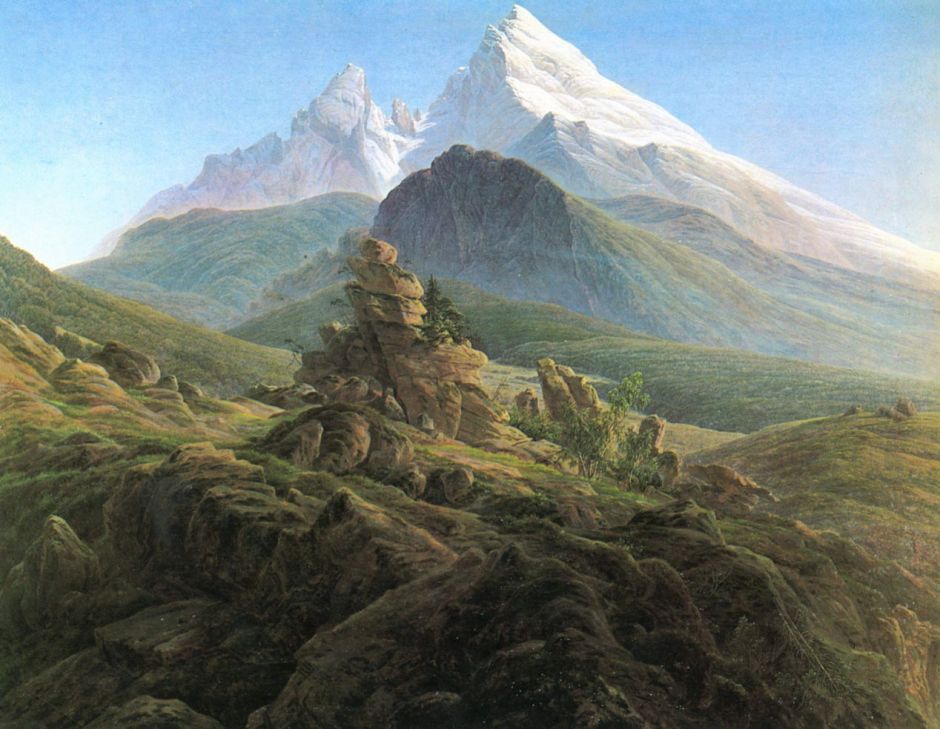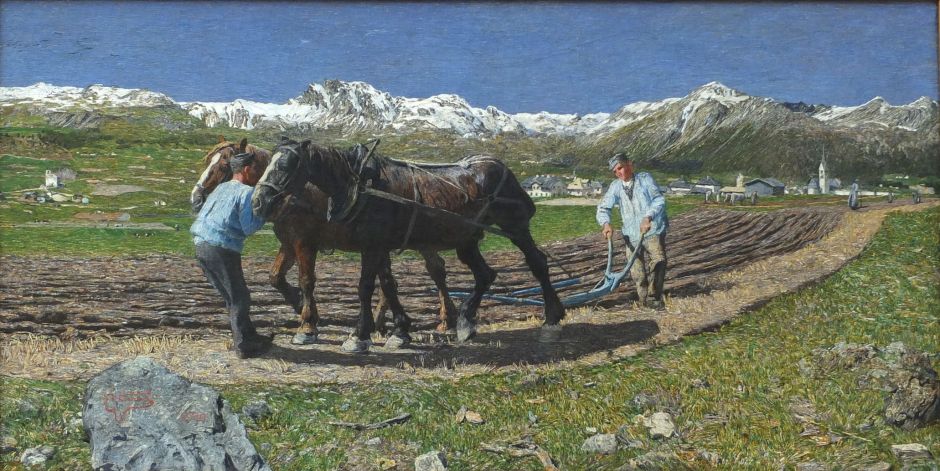Many major mountain ranges consist of peaks rising from an elevated plateau. While those peaks are barren and inhospitable, the uplands around them are usually inhabited and farmed, at least during the summer. In some areas, those living in lower valleys migrate each year, taking their livestock to summer pastures on the elevated plateau, and returning to their families in the autumn to spend the winter months down in the lowlands.
This seasonal pastoralism has been practised widely in mountainous regions around the world since prehistoric times, and has left its footprint in our languages, in the words used for the dwellings occupied during the summertime: hafod (Wales), shieling (Scotland), seter and its variants (Nordic), for example. Networks of drovers’ roads developed across those regions to support the movement of livestock between their lowland and upland grazing. These high or alpine meadows have also featured in paintings.

Caspar David Friedrich’s view of The Watzmann (1824-5) is unusually deserted, with rock runs and barren land in the foreground, and patchy low grass. The middle distance contains rolling forest, behind which the land rises abruptly in a rock cliff, and a rock hill showing intensely folded strata. The Watzmann is the third highest peak in Germany, and is south of the village of Berchtesgaden in the Bavarian Alps.

Although dominated by the mules themselves, Rosa Bonheur’s Spanish Muleteers Crossing the Pyrenees (1857) incorporates one of her most spectacular landscapes, which she may have painted in collaboration with her father. Mules like these were an important means of trade over the Pyrenees at the time, via traditional routes over passes that have been used by animals and humans for millennia.

Bonheur’s Weaning the Calves (1879) is set in a glorious summer Alpine or Pyrenean landscape, with a dry stone herdsman’s hut at the left, where the menfolk lived away from their families for the summer season.
At the end of the nineteenth century, Giovanni Segantini painted en plein air in the high meadows of the Swiss Alps, producing a series of symbolist landscapes that also form a record of life there.

Segantini painted his first non-Divisionist version of this view in 1886, then in 1890 made this second version of Ploughing using Divisionist technique. Comparison with a photograph of the artist with the first version shows that this location was just to the south-east of the village of Savognin, in Switzerland, with some minor adjustments to the view. This village is at an altitude of 1,200 metres (4,000 feet), and is occupied year-round.

The Punishment of Lust, from 1891, was Segantini’s first major Symbolist work, and is the antithesis of several paintings of good motherhood. Its literary basis is the poem Nirvana by his friend Luigi Illica, based on the visions of Alberico da Settefrati, a twelfth century Benedictine monk. Two partially-clad young women wrapped in white shrouds hover in mid-air above the snow of an Alpine plateau. Two more women are floating further into the distance at the left. The artist wrote that these women are ‘wantons’ being held hostage in the space above a nirvana of ice and snow. The landscape shown here is Lai Tigiel, high above Savognin.

The Bad Mothers from 1894 is its companion, with the same literary basis, but here showing a mother whose hair has become caught in the twisted branches of a barren tree, contorting her body to mirror the tree’s form. Trying to suckle at her breast is her child, who she spurns. Two other mothers are in similar situations deeper into the painting, to the left. This tells of the long and arduous path of atonement for mothers who indulge in hedonism and deny their love to their children.

Segantini’s High Noon in the Alps (1892) is one of a pair of paintings showing a shepherdess enjoying a brief break in her work, in the intense summer sunshine high in the mountains.

Returning Home from 1895 is based on Segantini’s personal experience of a family taking the body of their son home on a cart. He recasts the story to that of parents recovering their dead son from a foreign place, where he had fallen on misfortune. The landscape is that of Maloja in the Engadine, where the artist was then living, the village church being visible to the left.
In 1898 Segantini started work on a large triptych to be painted entirely in front of the motif.

Life (1898-99), the left panel, shows the last rays of daylight on the high pastures near Soglio. The small pool reflects part of the moon, while a mother nurses her child at the foot of a tree providing repoussoir. On the path crossing the canvas, a man is beating a calf to the consternation of its mother, and two women carry their children on their backs. This marks the beginnings of all life.

The centre panel is Nature (1898-99). The sun has just set behind the distant peaks, as a farmer and his wife take their livestock back to the barn for the night. The woman draws a young calf along, its mother following. The low horizon follows the Golden Ratio, and emphasises light as the primordial force in nature.

The right panel is Death (1898-99). Even the earth is stiff and dead, buried under several metres of snow, the shroud of death. A small group of women are gathered to mourn a child, who is brought out of a house wrapped in a shroud. A doleful horse stands ready with a sled to take the mortal remains to the graveyard. Above them, a peculiar cloud appears to embrace the mourners with its nebulous angelic wings.
In September 1899, Segantini set off to work on the central panel on the Schafberg Mountain, when he became ill with acute appendicitis. He died of peritonitis later that day.

Adrian Stokes’ Autumn in the Mountains (1903) shows a stand of birch trees and two deer in the rock-strewn upland pastures of the South Tyrol, with serious snow-covered mountains in the far distance.

I cannot identify the upland area in which Elizabeth Nourse painted The High Meadow in 1904. It appears to have been made in front of the motif in the foothills of the Pyrenees in the south-west of France, or in central eastern France near the Alps. Here a young cowherd is taking part in what may have been his first transhumance, a major step in the transition to becoming an adult.

In 1907, Koloman Moser travelled out to the nearest mountain range to Vienna, the Rax Alps, only about an hour away by train, and painted one of his first major landscape works, this View of the Rax. These mountains aren’t particularly high, rising to a plateau at about 1,500 metres (under 5,000 feet) with peaks which only just reach 2,000 metres (6,500 feet), but they look suitably rugged. Summer pastures are clearly visible in the gently rolling hills of the plateau.

